REPORTED BY RAJIV MALIK, DELHI
The town of tiruvannamalai surrounds Arunachala Hill, a premier place of pilgrimage for Siva worshipers. Anyone you meet here will recount the Puranic story that this is where Siva appeared to Brahma and Vishnu as a pillar of fire. Lord Vishnu and Lord Brahma were disputing which was the greater God, the story goes, when suddenly a seemingly endless pillar of fire appeared before them. They agreed that whoever could find its end would be acknowledged as the greatest. Vishnu took the form of a boar and burrowed into the earth, while Brahma took the form of a swan and flew upwards. Neither succeeded. Upon their return, Lord Siva revealed Himself from the pillar of fire, and both Gods acknowledged Him as supreme. Each fall this event is celebrated during the Karthika Deepam festival, which attracts over three million devotees. An enormous pot of ghee is ignited on the hilltop, creating a pillar of fire that can be seen for miles.
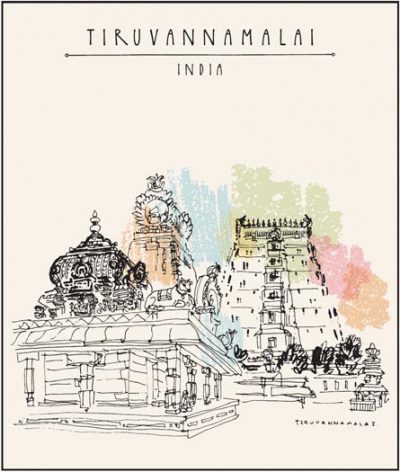
At the base of the hill sits Annamalaiyar Temple. Of the five elemental temples to Lord Siva—air, earth, fire, water and akasha, all located in South India—this is the fire temple. At 25 acres, it is by one account the sixth-largest temple in India. It was described by the 7th-century saints Sambandar and Appar and was developed extensively from that time by the Cholas and subsequent dynasties. From the 17th century onward it suffered under Muslim and then British rule, but today it stands as a marvelous and well-kept example of Dravidian architecture, with a full slate of daily worship and festivals.
In recent times the town gained fame as the residence of Ramana Maharshi (1879-1950). His ashram remains the most popular destination in the area [see sidebar, page 23]. It is a place of profound sadhana, with thousands of visitors seeking to discover “Who am I?”—the question Ramana posed to each one who came before him. Other famous saints have lived here too, including Ramana’s contemporary Seshadri Swami and, more recently, Yogi Ramsuratkumar. As well, there are popular sadhus among the hundreds who call this place home, some with established ashrams, and others wandering through the town, sleeping and eating where they will.
Hundreds of thousands of devotees assemble here each full-moon day to do girivalam, the barefoot nine-mile circumambulation of Arunachala Hill. They come from miles around, including from Chennai, to undertake this penance. A substantial number are young professionals.
In this article we cover these main places, people and events, beginning with girivalam. Our reporting was assisted by local advocate Palani Raj, recommended by Jayendra Puri Swami of Kailash Ashram, Bengaluru. For imagery, we engaged local photographer Sundaram Sethu.
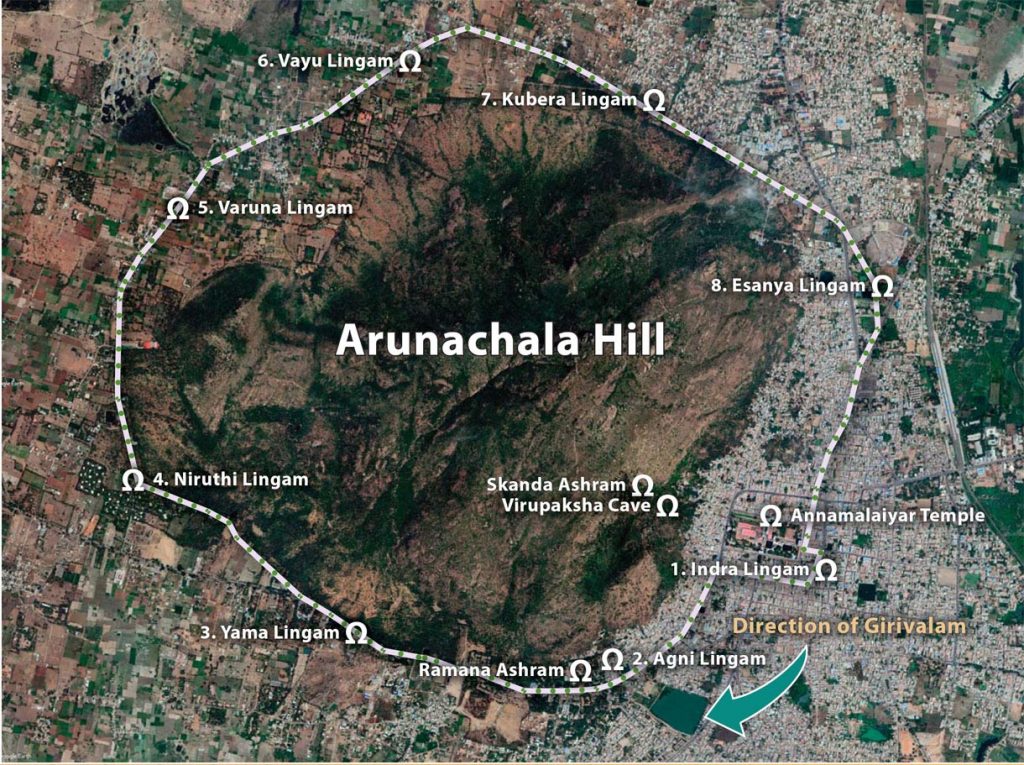
Circling the Hill
Our trio arrived for the full moon of January 30, 2018, which coincided with the Thaipusam festival. There was also a full eclipse of the moon on the 31st. Most pilgrims for the girivalam (literally, “around the mountain”) arrive in the late afternoon. They circle the hill after sundown, avoiding the heat of the day, then return home. Most come by bus, some by car or train. Huge temporary bus stands are set up at several points around the city so as not to interfere with the movement of the pilgrims. Buses arrive every few minutes to discharge passengers. All are in a festive mood, with the women dressed in colorful saris. Ila Maram, a senior traffic officer, tells us the rush is less this time because of the Thaipusam Murugan festival, the lunar eclipse and the full moon falling on a working day instead of a weekend. The rapid arrivals and departures explain how this relatively small town of 145,000 can manage many times its population of pilgrims.
The circumambulation begins and ends in front of Annamalaiyar Temple. The girivalam path is a well-maintained two-lane road with trees along both sides. An attempt in 2017 to widen the road, which included cutting down these trees, was met by stiff local resistance. Fortunately, the tree cutting part of the plan was subsequently abandoned. In places, the road is lined with shops; at others it is open on both sides. Streetlights have been installed, and with the full moonlight one can easily walk without the need for a hand-held light. Soon after sunset, when the road has cooled from the blistering heat, it is packed with pilgrims, nearly all barefoot.

Along the route are many sacred places. The most important are the Ashta (eight) Lingam temples, located roughly at the eight compass points around the hill. Neglected during a century-plus of British rule, these were renovated by Moopnar Swamigal in the early 1900s. Swamigal believed the restoration of these shrines was needed to revitalize the fields of energy and influence that surround Arunachala hill. It is not required to worship inside all eight temples, and some are a bit off the path, but devotees acknowledge each as they pass.
It is said that undergoing the walk around the holy mountain removes sins, fulfills desires and bring spiritual freedom. Devotees move along the road silently in a meditative state or chanting “Annamalai Haro Hara!” or “Aum Namah Sivaya.” There is little talking; in fact, it is a bit difficult to get people to stop for an interview, so strong is their intent.
We encounter a group of five from Kanjivaram, about 62 miles away, doing girivalam in the daytime. One of them, Manikandan, explains they came by bus. They started out at 6am, arrived by 10am and will return the same evening. Agricultural workers, they were not deterred by the hot pavement: “We do not mind walking barefoot in this heat, as we are doing this for God. It is our belief that many realized siddhas walk on this path and do girivalam on auspicious days, and we feel that we will get their powers and blessings only if we walk here barefooted.”
Manikandan add, “All of us have greatly benefitted by coming here on auspicious days. We feel peaceful and happy after performing girivalam. We have benefited more in spiritual terms than material terms. Our health and well-being have also improved.”
Another pilgrim we meet is Thangavelu, 62, who says something inside him had told him to wait and talk to us. “I normally do not speak with anyone and just keep chanting ‘Aum Namah Sivaya’ as I walk on the path. I do not come with friends, as they indulge in gossip.” He says he has done girivalam 238 times—monthly for 20 years!
Ramu Subramaniyam is among a group of young professional men who arrived from Chennai. He explains the motivation: “There is definitely some higher level of divine energy here which we feel whenever we come to this area. We all experience certain things, and that is the reason we come here again and again. If there are any problems that we face, we find them solved after we have gone through girivalam.”
One of the many sadhus present along the path tells us pilgrims offer them money without being asked, and this covers their travel expenses. Various NGOs and religious organizations have organized feeding programs both for sadhus and pilgrims.
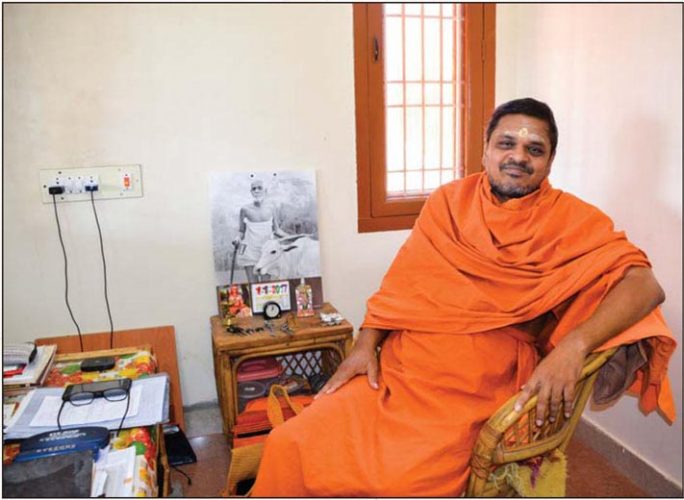
Each of the Ashta Lingam temples is noted for a particular boon. The second, the Agni Lingam, is known for blessings of good health; the third, Yama Lingam, for solving financial problems and granting long life; the fourth, Niruthi, for childless couples to conceive, and so on. In front of each temple is a table where one can light a camphor lamp; many pilgrims just do this and do not go inside.
Roadside shops are numerous. Several, selling devotional CDs, blare loud music from speakers. This and other disturbances are an unfortunate side effect of the popularity of girivalam. Long stretches of the road now have commercial establishments on both sides. There are even high-rise buildings that block your view of the holy hill as you walk.
Overall, I noticed a marked difference between the pilgrims I spoke with here and those at the Kumbha Melas. There, many are rural folk, carrying their luggage on their head as they proceed through the Mela grounds, where they will stay for the night or longer. Here, the pilgrims look wealthier and healthier. They are peaceful and calm as they do this hours-long walking meditation. Since they will soon return home, they need not worry about accommodations or luggage. At most, they might be carrying a small bag.
Circling back around to the entrance of Arunachaleshwara Temple, we come upon a scene of mild chaos as those ending the girivalam mingle with those just beginning. Men are tossing offerings of camphor into a huge burning pot in front of the entrance, oblivious to the heat from the fire. Many of the women are lighting beautifully decorated earthen lamps on the ground and drawing kolam designs around them. So uplifted is everyone that few wish to be interviewed. Bhupati, age 30, kindly spoke with us. He credits his practice of girivalam for his good job, excellent wife and lovely son. The strong sense of devotion is overwhelming.
Local Ashrams
Tiruvannamalai is world famous for SRI RAMANA ASHRAMA, which experiences a constant stream of Indian and international visitors. As a reporter I have been to many ashrams, temples and pilgrimage destinations, including Amarnath Cave, and attended all four Kumbha Melas. But here at Ramana Ashrama the serious level of self enquiry surpasses all of them. Everything revolves around the three words, “Who am I?” Devotees meditation intently in the ashram’s Old Hall, where Ramana Maharshi used to give darshan, in the Om-shaped Virupaksha cave partway up Arunachala hill where he lived from 1899 to 1916, and at Skandasramam, the nearby tree-shaded hermitage where he lived from 1916 to 1922.
Ramana himself explained, “The thought ‘Who am I?’ will destroy all other thoughts, and like the stick used for stirring the burning fire, it will itself in the end get destroyed. Then, there will arise Self-Realization.” It is the charming custom of this place to always refer to Ramana in the present tense, to acknowledge that he has not passed on, but is still living here on a subtle plane.
“This query, ‘Who Am I,’ is the only guideline which is given to everyone who enters Ramana Ashram,” said ashram administrator Shri V. S. Mani. “There is no prescribed process for sadhana, no! Informally, you interact with other senior people, like-minded people. Informally they will guide you. Nobody sits on a pedestal, talks down to you, no! If at all instruction is required, Ramana’s small booklet, Who Am I?, gives all the instruction required for sadhakas to progress.”
When we visited, the main hall was overflowing with devotees as the students and teachers of the ashram’s priest school chanted the Vedas at the shrine built over Ramana’s tomb. In addition to the ashram’s many temples and shrines, there is a large dining hall where hundreds of sadhus and devotees are fed every day, as well as a well-stocked library and bookstore.
Nearby and almost equally well known is SESHADRI SWAMIGAL ASHRAM. Seshadri Swami (1870–1929) was a slightly older contemporary of Ramana and first to recognize him as a great spiritual being. He spotted the boy meditating in the Patala Lingam cave of Annamalaiyar temple, convinced him to move to a better location for his meditations and helped heal the insect bites he had suffered while in samadhi. Seshadri also protected him from local boys who tried to disturb him.
Seshadri was known as the “Saint with the Golden Hand.” People say that when he was four years old, he entered a shop and requested his mother buy him an image of Krishna he had picked out. The shop owner, charmed by the young boy’s sincerity, gave him the statue, one of many which had just been delivered. By the end of the day, the shop had sold out all of the Krishna statues, a most unusual event and one which led the shop keeper to say the boy had a golden hand.
Seshadri Swamigal Ashram is less crowded than Ramana Ashram, and very peaceful. There are a number of small shrines and the samadhi (burial) places of Seshadri Swami and other saints. The ashram feeds hundreds of people a day, including a large number of sadhus, and has 90 rooms for accommodating ashram devotees.

A third major ashram is that of YOGI RAMSURATKUMAR (1918-2001). While Ramana and Seshadri represent an austere, meditative approach to spiritual life, Ramsuratkumar’s orientation is devotional. Originally from Uttar Pradesh, Yogi was also known as “Fan Swami” for the palmyra fan he used to carry. He was humble and down to earth, always referring to himself as a “mad beggar.” For many years he lived on the streets. In his latter years he oversaw the construction of this ashram.
We visit this ashram several times, and always it is overflowing with devotees and pilgrims. A group of pundits from Maharashtra, specialists in Shukla Yajur Veda, are spending several weeks here, and we hear their Vedic chanting when we visit. The huge main hall, Pradhan Mandir, can accommodate 4,000 people at a time. In the middle of this is a majestic metal statue of Ramsuratkumar which he installed himself. There is also a small Vedic gurukulam at this ashram.
The chant most often heard in this hall is the Yogi’s name: “Yogi Ramsuratkumar.” The saint gave this to his devotees as the best way to maintain touch with him. Also heard here is the mantra “Om Sri Ram Jai Ram Jai Jai Ram.” Yogi’s guru, Papa Ramdas, had initiated him with this mantra.
Once the ashram was built, Ramsuratkumar gave darshan to devotees in a small hut located inside this hall. The hut now houses a life-like statue of him. On the southern side is the samadhi shrine where lie his mortal remains, and along the walls are paintings of scenes from his life.
This ashram has perhaps the best infrastructure of any in Tiruvannamalai since it is a modern ashram, recently constructed. A huge kitchen is adjacent to a very neat and clean dining hall, where meals are provided free of charge for saints and devotees.
We spoke with two of Yogi’s senior disciples, Ma Devaki and Ma Vijay Lakshmi, who related three of his key sayings: “Remembering God is life. Forgetting God is death;” “Remembering God is dharma. Forgetting God is adharma;” and “My Father alone exists, nothing else, nobody else.” By “Father,” the two disciples explained, he sometimes meant his guru, and other times his Supreme God, though to him there was no difference.
KAILASH ASHRAM here, a branch of Sri Kailash Ashram in Bengaluru, was founded in 1999 in collaboration with the government of Tamil Nadu. It runs a full-time music school with 72 students under the direction of Ravi Shankar, an expert in the nadaswaram horn. The school offers training in vocal, thavil, devaram, nadaswaram, Bharatanatyam, violin and mridangam. Its students often perform at the Annamalaiyar Temple, especially during the Karthika Deepam festival. They are also invited to other cultural and religious events in the town.
SRI ARUNACHALA RAMANA ATMA VIDYA MANDIR is a new establishment on the outskirts of town, run by Swami Ramana Swaroopananda. He greets us most warmly, as he just recently visited HINDUISM TODAY’S headquarters in Kauai, Hawaii. In fact, we repeatedly meet people here who are familiar with the magazine or have even met its founder, Sivaya Subramuniyaswami, during one of his several visits here.
Fluent in both Tamil and English, Swami Swaroopananda has set up this temple/ashram based on the teachings of Ramana Maharshi. He is especially known for his spiritual discourses, and is a major proponent of girivalam. He deplores the commercialization of the girivalam route, which he feels is distracting to the serious pilgrims. He is also concerned about developments on the hillside itself which, in some places, already obscure the view of the hill.
Swami explained, “Again and again, Bhagavan Ramana Maharshi said, ‘Even Mount Kailash is only the abode of Lord Siva; but here Arunchala is Siva himself.’ That is why our Nandi here faces the hill. Ramana had seen inside the hill with his inner vision and said it is a garden with a waterfall and lake where yogis and siddhas are meditating continuously. He said if you come here and sit at the feet of Arunachala, your mind just melts and you become one with Siva. Arunachala, which is outside, is within us as our Self. That is the purpose of this place: self-inquiry—Who am I?”
He mentioned how the famous musician Ilayaraja and the even more famous actor Rajinikanth have been instrumental in promoting the area. Both hold Ramana Maharshi in high regard and often pilgrimage here.
Saints, Sadhus and Siddhars
Shortly after arriving in Tiruvannamalai, we are told of Mooku Podi Siddhar, also known as “snuff swami” for his love of powdered tobacco. He lives at the Bhupati Coffee Shop and sleeps on a bench under a green cloth which usually completely covered him. He seldom speaks, and only rarely looks anyone in the eye. Any glance of acknowledgement from him is considered a great blessing. He is known to shout at and chase away some people. But for all this, he is considered one of the most spiritually powerful of all sadhus in the area.
One day we stop at the coffee shop just as the scruffy holy man is coming out and starting to walk on the main road. Immediately a large number of people start to follow him, hoping he will offer them some form of recognition. Traffic on the road nearly comes to a stop as onlookers salute him with folded hands. He walks about ten minutes to Udupi Brindhavan restaurant, where he is immediately served food and afterwards enjoys several packets of snuff devotees left for him.
According to our guide, Palaniraj, he sleeps and eats wherever he pleases, and none will chase him away. For me this encounter is an extraordinary experience, his direct glance alone putting me into a state of bliss. Like Srisiva Jothi Mona Siddhar (sidebar page 25), Mooku Podi is regarded as a siddhar of the highest caliber, though certainly his manner is strange. These are people one only hears stories about from distant places and times; actually meeting one face to face is an experience not easily forgotten.
By comparison, SADHVI VARALAKSHMI, age 60, is a far more traditional and sedate person. Born in Andhra Pradesh, she was so attracted by Arunachala Hill and Ramana Maharshi during a visit that she decided to settle here permanently. She did girivalam daily for 22 years, and eventually built a temple to Goddess Lalithambigai, a form of Durga. She also founded the Ramana Maharshi Old Age Home. Both are located in her well-appointed ashram where we meet.
She has a charming presence, blissful and contented. She will chant “Ramana!” or “Arunachala!” periodically as one sits with her. She doesn’t teach in the sense of giving lectures, does not accept any disciples, but directs everyone to the Ramana’s teachings.
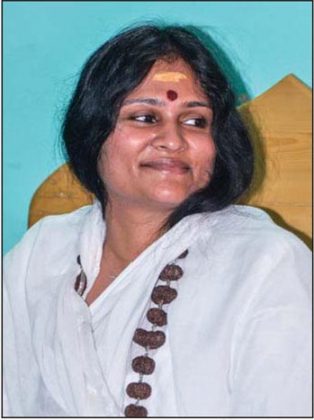
MADHAVI KANUMURI, 45, is not a sadhvi, but considers Ramana Maharshi her guru and calls herself a spiritual counselor. She explains the mission of her Arunachala Ramana Sundara Charitable Trust: “Now that I am blissful and contented, I want to share my experiences with others, so that they can also attain this state of blissfulness. I offer spiritual counseling to around 2,000 people. I hold satsang classes and programs for the empowerment of women.”
In a chance meeting at Kailash Ashram we were introduced to a young and dynamic sannyasini, SADHVI AMBA, who resides here while her own ashram, Antakarna Dhyana Nilayam, is being built. She considers herself a disciple of Bhagwan Nityananda of Ganeshpuri, though he attained Mahasamadhi before she was born.
Our interview with her is profound. Here we will share only her views on girivalam, reserving the rest for a future issue. “The experience during girivalam just calms you intensely, completely blanks out all your thoughts for the entire three and a half hours, especially if you are chanting ‘Om Namah Sivaya.’ You can literally feel some layer of karma getting cleansed, some burden is getting shifted from you, and you can feel that emptiness within. This is a land of spiritual discipline, of knowledge. If you want to attain anything spiritually, this is the hub. I have been to many places in Himalayas. I have circumambulated Mount Kailash. But the feeling, the energy that I find in Arunachala is something I have not experienced elsewhere.”
Westerner Seekers
We encounter many foreign seekers in smaller and larger numbers at every ashram and along the girivalam path. Their sincerity is impressive. Local sources informed us that on a typical day 50 to 60% of the devotees at Ramana Ashram are non-Indians, a like number at Seshadri Ashram and perhaps 10% of those participating in girivalam on any given day. During the hottest season their numbers will be much less.
Andres Wormull, 45, has been to Tiruvannamalai nearly twenty times, bringing groups from his home country of Chile to share the magic of the place. He tells us, “I just explain a little bit to my group members about Arunachala. The rest they have to feel themselves. After all, there must be a reason why, over the ages, all the mystics and saints have given so much importance to this holy place. That is the difficult part; you have to shut your mind so that your heart opens.”
Meenakshi Ammal, 66, originally from Ireland, is one of several we meet who were instructed by Satya Sai Baba to move here. She is a kind and graceful lady who runs a huge website, www.arunachalasamudra.org. She was most helpful in our research for this article. Among many insights she shared with us, one on Ramana’s teachings stood out: “He said that self-inquiry was the only sadhana that has no danger, because self-inquiry is the only sadhana that attenuates, thins, the mind. When you do mantra and sutra, you create a powerful mind to destroy the mind. When you do self-inquiry you are reducing the mind, withdrawing your vasanas [impressions from the past] and everything else.”
“While our Indians want to go and settle abroad for gaining material gains,” observes Swami Brahmananda Saraswati, “foreigners leave their material possessions and settle here so they can live in blissfulness and peace. There are thousands who have settled here once they tasted the nectar of Arunachala. ”
In Conclusion
Scriptures clearly state that one who has had the darshan of Arunachala will be liberated; that the significance and importance of Arunachala is so great that just by its remembrance, smaranam, thereafter one will be forever liberated and blessed. Everyone we met in Tiruvannamalai pointed this out. The place and its people are quite unlike what one finds in Haridwar/Rishikesh, where pilgrims go to bathe in the Ganga, worship at some temples and visit a few ashrams, but then embark on river rafting and other holiday activities. Here one does not find such duality of purpose diluting the spiritual efforts. Arunachala’s impact is unique in that here devotee focus entirely on sadhana—from the pilgrims on girivalam to the longer-term residents in the area’s many ashrams, and even among many common folk who happen to live here. All in all, Arunachala Hill and the surrounding area is an extraordinary place.

THOMAS KELLY
EXPERIENCING TIRUVANNAMALAI: Ramana Maharshi; a family departs his ashram
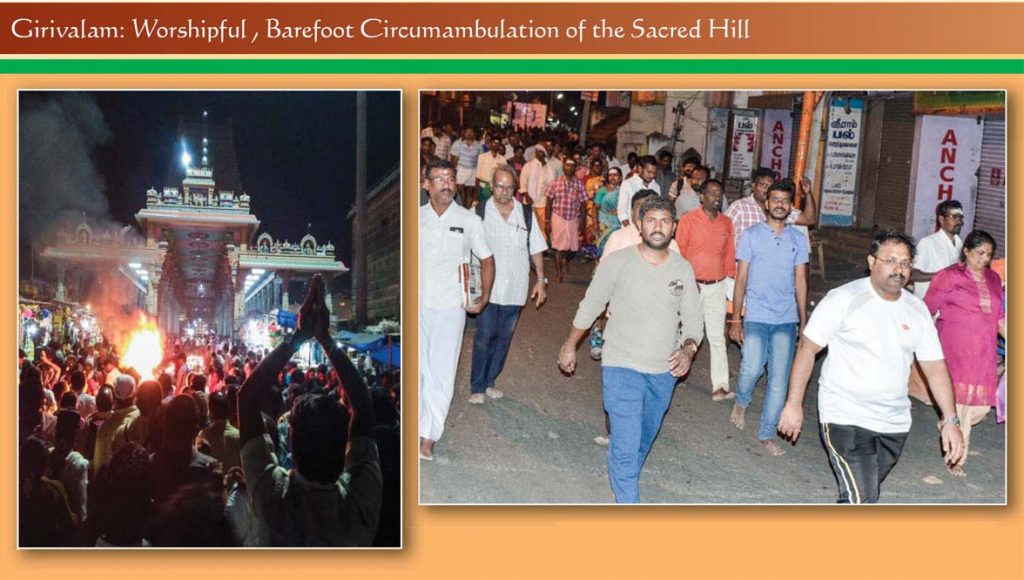
Devotees begin and end the nine-mile girivalam at the front entrance of Annamalaiyar Temple; barefoot pilgrims stride the sacred path at night to avoid the intense daytime heat
The Austere Life of Sage Ramana
Excerpted from Hail Arunachala by B. Palani Raj
Bhagavan Sri Ramana Maharshi (1879-1950), the great sage of Arunachala, was responsible for spreading the grace and glory of Tiruvannamalai to all parts of the world. His method of Self-Realization by inquiry attracted the attention of multitudes of people both in India and abroad. Bhagavan’s biography, spanning a half century spent in this holy place, is the history of Arunachala for that period.
Sri Ramana was born in 1879 in Tiruchuzhi Village, about thirty miles south of Madurai in Tamil Nadu, to a brahmin couple, Sundaram Iyer, an uncertified pleader (unlicensed attorney nevertheless allowed to represent people in the local court) and Alagammal. The child was named Venkataraman, and he did his schooling in Tiruchuzhi followed by studies in Scots Middle School and the American Mission School in Madurai. In November, 1895, one of his relatives informed him that he had been to Arunachala. The very mention of the name Arunachala inspired the young Venkataraman and stirred in him a desire to visit that holy place. In July, 1896, even though he was in robust health, a mysterious apprehension of his death seized him; this impelled him to introspect what would happen to the “I” within him even if his body suffered death. The inward search drew him to Arunachala where he sought and achieved the ultimate goal of nirvakalpa samadhi, Self Realization.
Sri Ramana reached Tiruvannamalai in 1896 at the age of 16. Upon his arrival, mysteriously all the gates and inner doors of the big temple of Arunachaleshwara opened wide to receive him. Later he arrived at the holy Ayyankulam tank near the temple where he set aside his sacred thread that marked his identity as a brahmin, and did away with the clothes covering him, retaining only a small piece to wear around his waist as a loincloth—his chosen attire for the rest of his life. He chose several places for his meditation in and around the temple: Guru Murtham, Patala Lingam in the big temple, a place near Subramanya Temple, the Mangai Pillaiyar Temple, the Mango Tree Grove, and Virupaksha cave on the hill itself.
Within a short period Sri Ramana became popular and had a number of followers, who used to chant the verses of “Akshara Manamalai,” a song composed by the sage. At that time a great poet and versatile scholar, Kavyakanta Ganapati Sastri, who did meditation for 12 long years and yet could not grasp the true meaning of tapas (ascetic practice), approached Sri Ramana, who until then had been keeping silence in his enlightened state.
The great sage broke his long silence and explained in Tamil as follows: “If one watches where the notion ‘I’ springs in the mind, the mind is absorbed into that. That is tapas. When a mantra is repeated, if attention is directed to the source where the sound is produced, the mind is absorbed in that. That is tapas.” The words of Sri Ramana convincingly satisfied all spiritual questions of Kavyakanta. This same scholar suggested to his devotees that “Ramana Maharshi” was the proper appellation for Sri Ramana and that they should address him as “Bhagavan.”

THE MEDITATOR: Ramana, in 1902 when he was 22 years old
Kavyakanta took Mr. Frank Humphreys, an Assistant Superintendent of Police, to Bhagavan in 1911. Humphreys was the first European to visit Bhagavan, and his impressions were recorded in London’s The International Psychic Gazette: “I could only see his body was not the man, it was the instrument of God, merely a sitting motionless corpse from which God was radiating terrifically. My own sensations were indescribable.” Humphreys questioned him, “Master, will I be helpful to the world?” Bhagavan’s answered, “Help yourself, then you will help the world.” Thus, Humprhey’s explained, the whole teaching of Bhagavan Sri Ramana Maharshi pivoted on his philosophy, ‘Know thyself, and you will know everything and have nothing more to know.’ Bhagavan advocates a very simple process of self-enquiry, namely asking oneself, ‘Who am I?’”
Paul Brunton was a European journalist who visited Sri Ramana in the 1930s and gave a graphic picture of the great saint in A Search in Secret India, published in 1934. The Westerners who read this book and his two other books, Secret Path and Message from Arunachala, flocked to Ramana Ashram in great numbers. The famous English writer Somerset Maugham came, and his reminiscences were reflected in his novel The Razor’s Edge.
To some devotees at Ramana Ashram the Maharshi was revolutionary because of his notion that women and sudras (low castes) are fit enough to learn the Vedic teachings. He had employed as his close attendants men of depressed classes and a Muslim, and he had ridiculed the practice of untouchability as far back as 1917. His compassion enveloped both humans and animals. Maharshi was responsible for educating devotees about the beneficial effects of circumambulating Arunachala and himself set an example of going around it with his followers for quite a long period of time.
On his deathbed Bhagavan remarked, “They say I am going away, but where could I go? I am here.” His luminous presence is felt to this day by his devotees in Sri Ramana Ashram. As Pascaline Mallet remarks in her 1938 book, Turn Eastwards, “It was as if he had been living in a sphere beyond the limitations of time and space.”

DURING A PILGRIMAGE TO INDIA, the famed sage of Sri Lanka, Siva Yogaswami (1872–1964), visited Ramana Maharshi sometime in the 1930s or 40s. Their meeting was remarkable in its simplicity: the two sat in silence for an hour in Ramana’s austere room. Even when they met and parted, not a word was exchanged. After hearing of the visit, people were eager to find out what had transpired. Yogaswami told them, “We said all there is to say.” Later he added, “We did not go with any desire. Summa we went. We stayed for about an hour. He did not speak at all. He is a great hero (mahaviran).” By summa, Yogaswami meant “perfect stillness, communion in silence.” Siva Yogaswami was the guru of Satguru Sivaya Subramuniyaswami, founder of HINDUISM TODAY magazine.
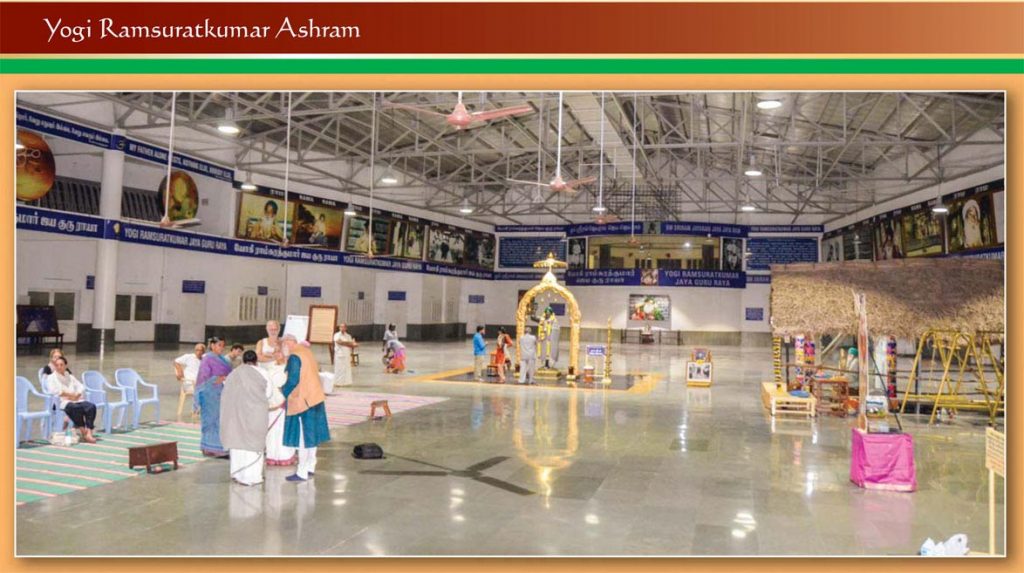
The huge main hall at the Yogi Ramsuratkumar Ashram
Srisiva Jothi
Mona Siddhar
One of the most impressive living saints we met here was Srisiva Jothi Mona Siddhar, head of the Dharma Paribalana Trust. (In the Tamil tradition a siddha is a highly accomplished sadhu or yogi, a “perfected one.”) His picturesque ashram (below) is about 20 miles from Arunachala Hill, nestled between a hill of boulders and a rice field. It has a constant flow of 500 devotees a day, a large free feeding program, and is noted for successfully counseling those who are addicted to alcohol. Swami spoke to us in Tamil, translated by Palaniraj.
“When I was a householder confronted with problems in my family, I went in search of the ultimate truth through self-inquiry and came here, to Tiruvannamalai. This area is full of caves where I did penance for seven years, taking no solid food; only tea. Through such sadhana, I attained this position.
“This material body can decay. It will perish, whereas the soul is permanent. If you realize the soul is permanent, if you come to that level, then you will be able to see the other siddhas who are in subtle forms. I am in contact with such siddhas because I have attained that level.
“People must be aware of imposters. Nowadays there are so many people in the guise of swamijis. Those who just extract money from people are the imposters. A person who is not after money is the real swamiji.
“Those people who come to me, they are all blessed. Their ills are removed. They are taken to a higher level. Then they will be able to do sadhana. Sadhana is nothing but chanting the name of Siva. ‘Om Namah Sivaya’ is the best sadhana one can do. I myself don’t believe in giving diksha (initiation), but try to uplift everyone who comes in contact with me.
“Like the Earth revolving around the Sun, if you go around the mountain, you get the blessings of all the siddhas there and the blessings of Lord Siva. This mountain is Lord Siva. That is true. I don’t see it as a mountain. It is Siva Himself. This is Linga. It is nothing but Linga. In this form of Linga, it is Siva. This is the very base axis of the whole world. From here only all siddhis are obtained by others. Anyone who comes in contact with this place is blessed.
“Here you have to realize who ‘I’ am. If you realize who ‘I’ am through self-inquiry, nothing else is needed. But people forget. They go into bad ways and spoil their bodies. This should be prevented. In coming to Tiruvannamalai, knowing thyself should be the ultimate motive. An ordinary man asks for wealth. It is a different set of people who seek realization of themselves.
“People coming to me complain about the sufferings they confront in life. My job is to give solutions for that suffering. That is the first step. Then after some time, when they are getting rid of their problems, we instill in their mind the concept and importance of self-inquiry. First their physical needs have to be met, and then only are they asked to seek the higher levels. Only then are they in a position to pursue self inquiry. A man who is hungry may not understand.”
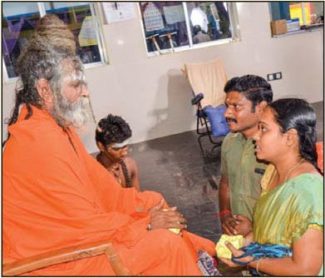
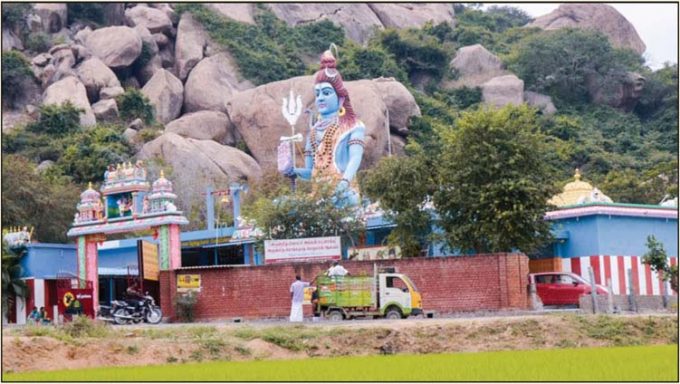
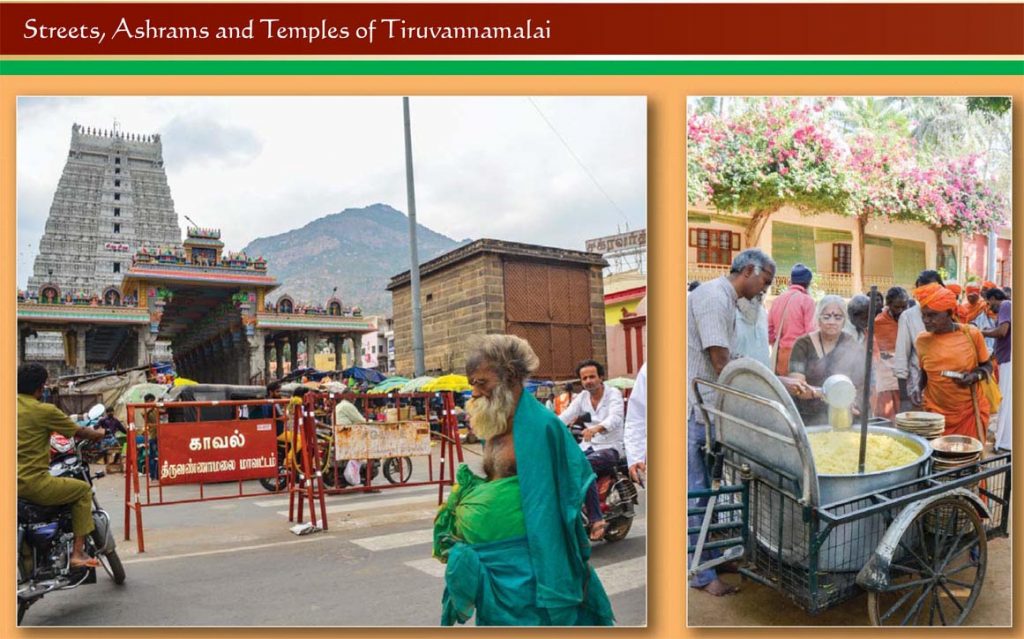
ALL PHOTOS: S SETHU
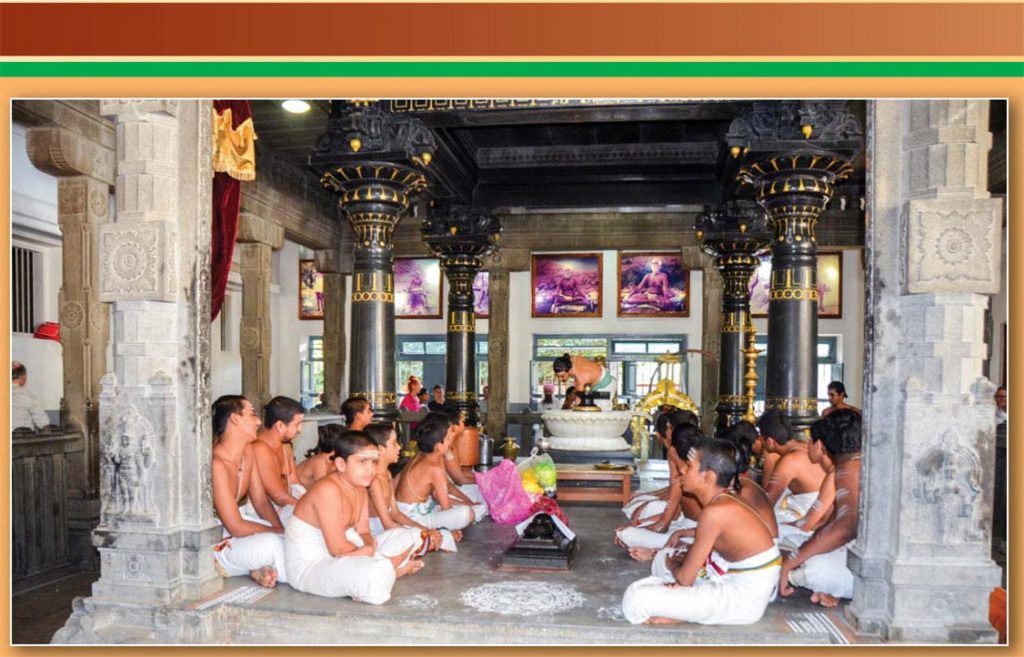



I was blessed to visit Sri Ramana Maharishi’s temple a few times when Dr. Muti so kindly allowed me to stay. Whilst in town l was guided to ‘The Silent Ama’ and went through a remarkable experience followed by another at the Temple. I was free from spinal pain & no longer needed pain killers and anti inflamatory medication – a true healing for which l’m truely greatful. My question is to ask about The Silent Ama , is she still living and having audiences? Best Regards Belinda/ Australia